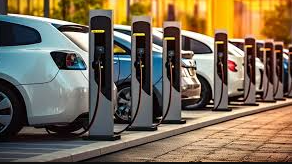A rise in electric vehicle users highlights the urgency for improved charging solutions.
SINGAPORE: As Southeast Asia embraces cleaner energy, Singapore stands poised to lead the charge in technology transfer and renewable energy infrastructure development, according to a senior official from a global environmental organization.
This push is particularly significant as Singapore intensifies its efforts to promote electric vehicle (EV) adoption, aiming to install approximately 60,000 charging points by the end of the decade. The nation plans to eliminate internal combustion engine vehicles by 2040 as part of its sustainability initiatives. So far this year, registrations for new zero-emission vehicles, including EVs and hybrids, have nearly tripled, now accounting for over 10% of new vehicle registrations.
A LEADING ROLE
Singapore’s proactive strategy to facilitate the widespread adoption of EVs has garnered attention. The World Wide Fund for Nature (WWF) has commended Singapore’s ambitious electrification plans, positioning it as a potential role model for decarbonizing transportation in the ASEAN region. “We believe Singapore can set an example for other countries to follow in their decarbonization efforts,” stated Ms. Stefanie Beitien, head of market transformation for WWF-Singapore.
She highlighted that nearly 90% of transport-related emissions in Southeast Asia stem from road transport, contributing to severe air pollution in urban areas. “Singapore’s involvement in EV adoption can extend to technology transfer, capacity building, and attracting investments into renewable energy and green infrastructure,” Beitien explained. She emphasized the need for electrification to be accompanied by increased use of renewable energy to ensure overall sustainability.
GROWING NUMBER OF CONVERTS
While still small, the number of EV enthusiasts in Singapore is on the rise, drawn by the lower environmental impact and reduced operational costs. One such convert is Mr. Ranjan Vaswani, who switched from a petrol-powered Volvo to a BMW all-electric SUV this year. “To me, the EV represents the next evolution of the car. It’s not only better for the environment, but using electricity is also cheaper than petrol,” he noted, adding that electric vehicles typically require less maintenance.
The Land Transport Authority (LTA) is collaborating with industry partners to establish a high-powered charging network aimed at high-mileage users like taxis, commercial fleets, and heavy goods vehicles. However, there remains insufficient demand among non-commercial drivers to justify significant infrastructure upgrades due to their infrequent usage.
“As we develop our charging network, we must consider that we are a small, densely populated city where most EV drivers average under 50 km per day,” explained Ms. Stephanie Tan, head of the LTA’s National Electric Vehicle Centre. “With EVs now offering a range of over 300 km, many drivers only need to charge once every five days, or even once a week. Therefore, low-powered overnight charging may suffice.”
Recent legislation mandates that new developments accommodate future EV charging needs. Additionally, the LTA has initiated a study to identify necessary infrastructure upgrades for public car parks.
CHARGERS READILY AVAILABLE
Singapore’s goal is to have 60,000 EV charging points by 2030. Accessibility remains crucial in determining where to install these chargers, according to Mr. Freddie Chew, general manager of ComfortDelGro ENGIE, one of the government-selected operators for deploying charging points across public housing car parks.
“We started by identifying suitable car park locations for EV chargers, focusing on accessibility and convenience for users,” said Mr. Chew. “Safety and proximity to power sources are also key considerations.” However, many car parks were not initially designed with EVs in mind, resulting in inadequate power supply for multiple vehicles.
“As is the case with most car parks in Singapore, they were not originally built with electric vehicles in mind,” noted Mr. Goh Chee Kiong, CEO of Charge+. “Consequently, many public and private sector car parks face limitations in power supply.”
To address this issue, some operators are employing technology to modulate charging speeds based on available power, allowing multiple vehicles to charge simultaneously on the same power load. Nonetheless, this is seen as a temporary solution. “This issue can only be managed through smart charging solutions over the next three to five years. In the long term, we need a comprehensive reevaluation of how to enhance power supply in many car parks,” Mr. Goh concluded.








